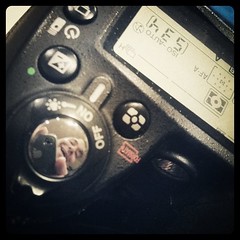Spot vs. Matrix Metering

1/125th of a sec | f/2.8 | 50mm | ISO 200
When a lot of people get a DSLR, a setting that they tend to overlook is the type of metering. Most cameras come set to Matrix metering by default and that’s where it stays. There’s a good reason for that – Matrix metering handles most situations really well. So why would you venture into the world of spot metering?

Shot on the iPhone with Instagram – never mind the goof in the shutter’s reflection
When I’m shooting something like people outdoors or indoors with a very strong directional ambient light source (like a window), spot metering is the way to go. In the photo up at the top of this post, birthday girl Caitlyn smiles for a split second for me. In this type of situation, I’ve got the camera in aperture priority mode, and the metering set to spot. Why? Well, I shoot in aperture priority mode because there are kids hopped up on birthday cake – this means largest possible aperture to get the fastest shutter speed because they are bouncing around like heated up Mexican jumping beans. There is also a huge window wall with the sun blaring right through it. For me this means I need to try to put my subject between the light source and my lens, preferably at a slight angle to get some sidelight.

1/250th of a sec | f/2.8 | 50mm | ISO 200
In order to not have the camera meter for the brighter background, I use spot metering and focus on my subject to get a meter reading off of their face. This will blow out the background, but that is perfectly accepted in today’s photography as it helps isolate your subject. The face and eyes are the important part of these photos, so that is all I care about in regards to exposure.

1/125th of a sec | f/2.8 | 50mm | ISO 200
Matrix metering was designed to address this kind of shooting, but like any automatic mode it lacks the intuitive decision process of the human mind. It will try and properly expose your subject, and a lot of the time it will not get too fooled by the brighter background because it will use a database of different shooting situations to guess what you are trying to do. But, it will try not to overexpose any part of the photo, so there is a chance that it will slightly underexpose your main subject. I know with spot metering that I will get the result I’m looking for each and every time. The real trick is to remember to switch it back from spot to matrix when you’re done shooting!
Thank you for is informative article. I am new to dslr photography and always wondered what the differences of spot and matrix are, now I know. So thank you, I will take this help and advice and apply it to my future works.
Thank you.
I know that I am responding late, but I found this article with a google search and others may as well.
One point: when you spot meter, your camera assumes you are metering off a mid tone color. So if you are photographing skin, for example, a spot meter will make light skin too dark–and dark skin too light. So you need to either use exposure compensation (if shooting i a priority mode) to let your camera know you are metering off something lighter or darker than a mid tone; or in manual mode, change the iso, aperture or shutter speed to compensate. Knowing how much to compensate depends on the tone of what you are metering off. If you meter off a mid tone color, then no compensation is needed. A pastel is +1, white with detail is +2, dark colors like maroon are -1, and black with detail is -2. Learn the Zone System to help you figure out what tones need what amount of compensation. There are some great videos called Perfect Exposure that helped me.
Also,(and this is not a perfect explanation) there is some argument that you should overexpose (but not blow highlights) on a digital camera if you shoot in RAW and then reduce the exposure in the RAW editor back to the correct exposure. This is called shooting to the right because it moves the histogram to the right of proper exposure. The reason for this is that digital cameras capture more tones in the lighter part of the histogram. When you underexpose in a RAW editor to make the exposure correct, the darker areas of the picture will have more tones becuase they were originally captured as lighter tones.
Fantastic insight Dave! I have also read about shooting to the right due to more data being able to be recorded. I did generalize this post, but the information you provided is spot on. Thanks for sharing – I’ll be sure to check out the Perfect Exposure videos as well!
@Joseph- Is it pssible to select your spot for spot metering through your viewfinder. For example through viewfinder autofocus point we can select any of the points and not only the one at centre of frame.
Similarly,for spot metering can i choose a point other than my viewfinder central point or recompose on half press if earlier one is not possible.
In that case will my autofocus and spot metering points be the same one that was selected from the viewfinder?
Basically, you select your focus point, if you can’t use your controls to move the focus point to a desired location, then depending on your camera’s settings you can lock the focus and exposure with a half-press. On my camera, I tend to use the AE lock button for this.